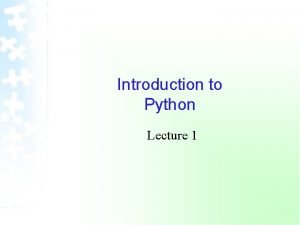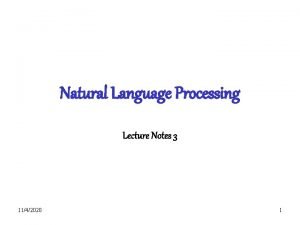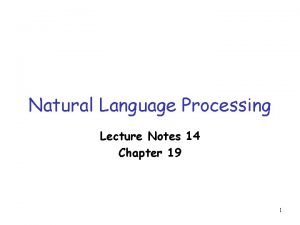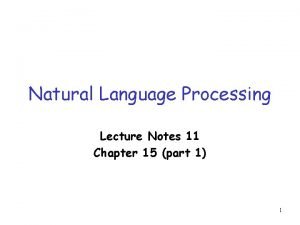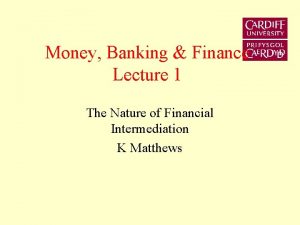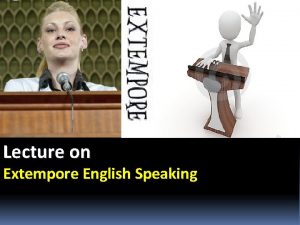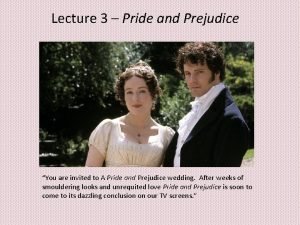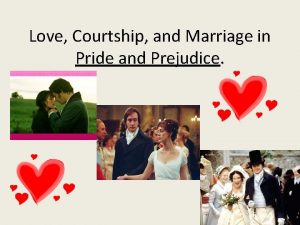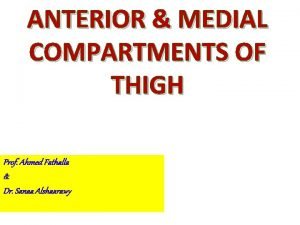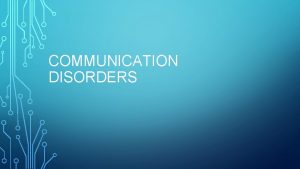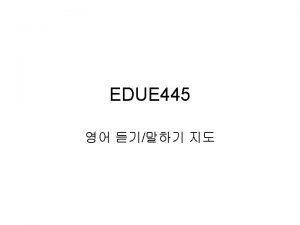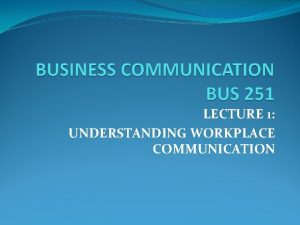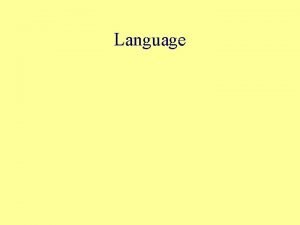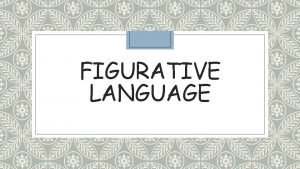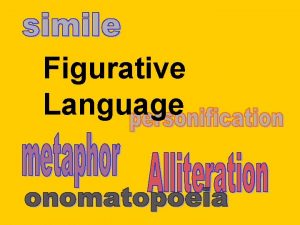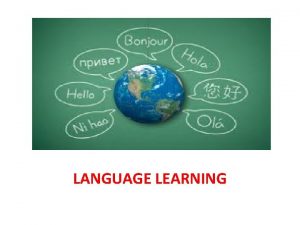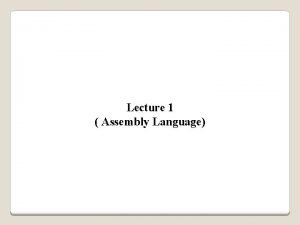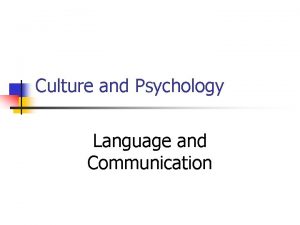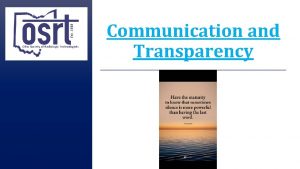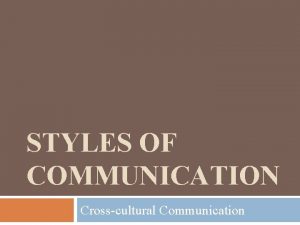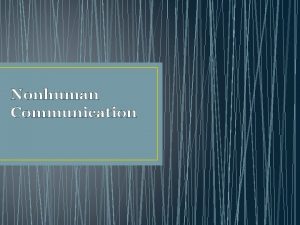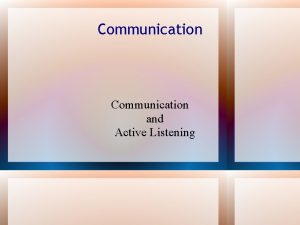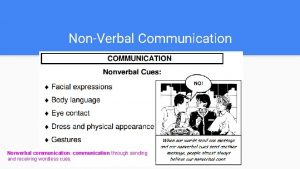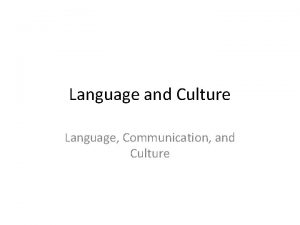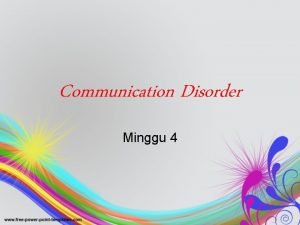Lecture 6 Language and Communication Language and Communication

































- Slides: 33

Lecture 6 Language and Communication

Language and Communication n Introduction n n Nonverbal Communication n n Functions and types Verbal Communication n What is communication? Language and cognition Attitudes and language variation Social Psychology of Bilingualism

What is Language? n Language is a sign and symbol system. It involves a set of rules regarding the linking of symbols to referents and their meanings and the linking of symbols to each other.

What is Language? n Language includes several subsystems: n Phonological system n n Morphological system n n grammar Semantic system n n meaning units (e. g. words) Syntactic system n n sounds meaning Pragmatic system n use

What is Communication? n Communication is a process during which source individuals initiate messages using conventionalized symbols, nonverbal signs, and contextual cues to express meanings by transmitting information in such a way that similar or parallel understandings are constructed by the receiving pry or parties toward whom the messages are directed. (Defleur et al. , 1992, p. 11)

Perspectives on Communication n Encoder-Decoder Model Intentionalist Model Perspective-Taking Model

Encoder-Decoder Model Source Channel Target Communication is a process in which an idea or feeling is encoded into symbols by a source and transmitted to a receiver (target) and decoded into the original idea or feeling.

Intentionalist Model n n n Communication involves the exchange of communicative intentions, and messages are a means to this end. Speech Act Theory (Searle, 1979) The Cooperative Principle (Grice, 1975)

Intentionalist Model, cont. n The Cooperative Principle (Grice, 1975) n n “Make your contribution, such as is required, at the stage at which it occurs, by the accepted purpose or direction in which you are engaged. ” Maxims n n Quantity Quality Relation Manner

Perspective-Taking Model n Communication is a process of both creating and reflecting a shared context between speaker (source) and listener (target). It involves the use of symbols whose meaning depends upon the shared context created by the participants.

What is Nonverbal Communication? n Nonverbal communication is defined as the way in which people communicate, intentionally or unintentionally, without words.

Nonverbal Communication n Functions of Nonverbal Communication (Ekman & Friesen, 1969) n n n Repeat what is said verbally Complement or clarify verbal meaning Contradict verbal meaning Regulate verbal interaction Substitute for verbal meaning

Similarities and Differences in Verbal and Nonverbal Codes (Burgoon, Buller, & Woodall, 1996) n n n n Discreteness Syntax rules Polysemy Arbitrariness Displacement Reflexivity Transformation Productivity n n n Analogic coding Iconicity Universality vs. culture/context bound meaning Simultaneity Sensory directness Spontaneity

Nonverbal Communication n Types of Nonverbal Communication n n n Facial Expression Kinesics - body movement and gesture Proxemics - use of interpersonal space Oculesics - eye gaze Haptics - touch Chronemics - time Paralinguistics - vocal cues and silence

Nonverbal Communication n Kinesics is the study of body movement and gestures n n Illustrators -- nonverbal gestures directly linked to language Emblems – nonverbal substitutes for spoken language

Nonverbal Communication n Proxemics n Hall (1959, 1966) Zones of Spatial Distance n n Intimate (18 inches) Personal (18 inches to 4 feet) Social (4 to 12 feet) Public (12 to 15 feet)

Nonverbal Communication n Chronemics n n Monochronic perspective: time is a scarce resource, which must be rationed and controlled. Polychronic perspective: time is flexible, used for the maintenance of harmonious relationships.

Verbal Communication n Language and Cognition n Linguistic determinism n n The language we speak causes us to think in a particular manner. Linguistic relativism n The language we speak predisposes us to think in a particular manner.

Language Attitudes: Definition of Attitudes n An attitude is a mental and neural state of readiness, organized through experience, exerting a directive or dynamic influence upon the individual’s response to all objects and situations with which it is related. (G. W. Allport, 1935)

Attitudes and Language Variation n “Persons have attitudes toward language which are especially salient and influential in initial interactions. Various linguistic features trigger in message recipients beliefs and evaluations regarding message senders and these beliefs and evaluations are most likely to affect recipient’s behaviours toward senders in contexts of low mutual familiarity” (Bradac, 1990, p. 388)

Standard and Non-Standard Speech Styles n n A standard speech style is the prestige form of a language, associated with the higher status group in a society. A nonstandard form is any variant from the standard form (e. g. , another language, dialect, accent), usually associated with the lower status group.

Hypotheses about Standard and Non. Standard Speech Styles n Inherent value hypothesis n n The standard dialect became the prestige form of the language because it evolved as the aesthetically ideal form of that language. Imposed norm hypothesis n Standard and non-standard dialects are equally aesthetically pleasing, but the non-standard form is viewed negatively because of social norms which are biased against it.

Research Approaches n n n Content analyses Survey research Experimental research

Matched Guise Technique (Lambert, Hodgson, Gardner, & Fillenbaum 1960) n Independent Variable n n 4 bilingual speakers read passage once in English and once in French = 8 passages Dependent Variable n Height, good looks, leadership, sense of humour, intelligence, religiousness, selfconfidence, dependability, entertaining, kindness, ambitious, sociable, character, likeablity

Evaluative Dimensions n Ryan et al. (1977) n Status n n Solidarity n n Educated-uneducated, wealthy-poor, intelligentunintelligent Trustworthy-untrustworthy, friendly-unfriendly, kind-cruel Zahn & Hopper (1985) n Superiority n n Attractiveness n n Literate-illiterate, educated-uneducated, upper class-lower class Nice-awful, kind-unkind, good natured-hostile Dynamism n Active-passive, talkative-shy, enthusiastic-weak

Evaluative Dimensions: Status and Solidarity Respondents from Higher Status Group Respondents from Lower Status Group

Language Attitudes and Discrimination n n Compliance Workplace Education Law Medicine

Probability of Employment Language Attitudes and Discrimination in the Workplace (de la Zerda & Hopper, 1979)

Other Speech Characteristics n Lexical Diversity n n n Vocabulary range, assessed through a type-token ratio (# of new words to total words) Evaluative reactions: status, competence, control, persuasiveness Speech Rate n n The number of words or syllables that speakers utter per unit of time (per minute is the standard unit) Evaluative reactions: competence, persuasiveness

Other Speech Characteristics, continued n Language Intensity n n The quality of language which indicates the degree to which a speaker’s attitude toward a concept deviates from neutrality (Bowers, 1963, p. 345) Evaluative reactions: complex, interacts with other variables.

Communication Accommodation Strategies n Convergence n n Divergence n n Moderation of a speech style, whether in terms of lexical diversity, rate, accent, language, and/or some other linguistic feature, to become more similar to the interactant Accentuation of a difference between interlocutors on one or a number of linguistic features. Maintenance n Refusal to alter communication style

Communication Accommodation Theory n n Social Exchange Theory Similarity-Attraction Hypothesis Causal Attributions Psychological Group Distinctiveness

Social Psychology of Bilingualism n Ethnolinguistic identity theory n n Second language learning n n Ethnolinguistic vitality Attitudes and motivation Ethnic identity and language n Additive and subtractive bilingualism
 01:640:244 lecture notes - lecture 15: plat, idah, farad
01:640:244 lecture notes - lecture 15: plat, idah, farad Crisis communications lecture
Crisis communications lecture Business communication lecture slides
Business communication lecture slides Natural language processing
Natural language processing Natural language processing lecture notes
Natural language processing lecture notes Big picture lecture language
Big picture lecture language Natural language processing nlp - theory lecture
Natural language processing nlp - theory lecture English language lecture
English language lecture Natural language processing lecture notes
Natural language processing lecture notes Natural language processing lecture notes
Natural language processing lecture notes Natural language processing lecture notes
Natural language processing lecture notes Electricity and magnetism lecture notes
Electricity and magnetism lecture notes Power system dynamics and stability lecture notes
Power system dynamics and stability lecture notes Microbial physiology and metabolism lecture notes
Microbial physiology and metabolism lecture notes Limits fits and tolerances lecture notes
Limits fits and tolerances lecture notes Parallel and distributed computing lecture notes
Parallel and distributed computing lecture notes Bilateral vs unilateral tolerance
Bilateral vs unilateral tolerance Financial markets and institutions ppt
Financial markets and institutions ppt Banking and finance lecture
Banking and finance lecture Extempore and lecture
Extempore and lecture Utilities and energy lecture
Utilities and energy lecture Catherine belsey books
Catherine belsey books Design of mechatronics system ppt
Design of mechatronics system ppt Foetotomy
Foetotomy Lecture on love courtship and marriage
Lecture on love courtship and marriage Power system dynamics and stability lecture notes
Power system dynamics and stability lecture notes Project planning and management lecture notes ppt
Project planning and management lecture notes ppt Base of thigh
Base of thigh What is oral communication and written communication
What is oral communication and written communication Diff between oral and written communication
Diff between oral and written communication Serial and parallel communication
Serial and parallel communication Project procurement management lecture notes
Project procurement management lecture notes Lecture about sport
Lecture about sport Lecture on healthy lifestyle
Lecture on healthy lifestyle





